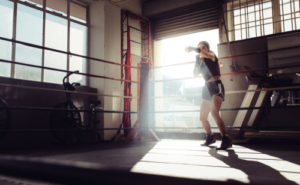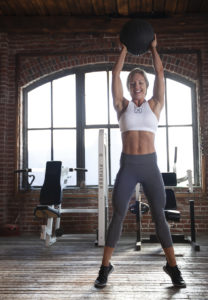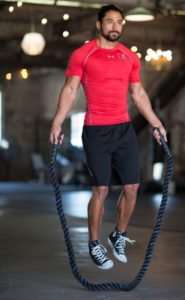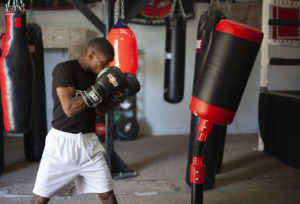
Before a match, we often compare fighters based on their power and their reach. We tend to break opponents down based on how hard they hit.
What often gets left out of that discussion, because it’s hard to quantify, is a fighter’s overall level of conditioning. And a fighter’s level of physical endurance is often a more critical indicator of success than any other factor.
But it doesn’t matter how hard you punch, if you can’t last long enough into the fight to land it.
A serious martial arts training regimen begins with developing basic conditioning. Whether you train for boxing, MMA, Muay Thai, Kickboxing, or some other martial art, you need to build your endurance both for the training and for the fight.
Why Focus on Conditioning?
First, when we say “conditioning” we generally refer to building endurance or stamina. That is, we improve the body’s ability to exert itself. Our goal in conditioning is to extend the amount of time we can continue to do any activity before we are tired, winded, or completely spent.
Successful fight training requires you to exert yourself for long hours, repeating the same movements over and over again. If you get tired too soon, your form will suffer. And you will start practicing the WRONG moves. Practicing on the bag with your guard down might be worse than not hitting the bag at all.
So you need to build up your endurance if you hope to gain any benefit from your training.
Then comes the goal of all that training: the fight itself. If you ever intend to get in the ring, you need to be able to push yourself, sometimes at close to maximum intensity, every round. Whether you’re training for 3 five-minute rounds, 12 three-minute rounds, or something in between, you better be able to keep going at your best for the duration.
Because when you get tired, you get sloppy. When you get sloppy, you stop protecting your chin, you miss your opponent’s tell, or just don’t move out of the way in time. And then it’s all over, in an instant.
To make sure we have the energy we need for training and competition, we focus on Aerobic training and Anaerobic training.
Building the Base: Moderate-Intensity Aerobic Conditioning
Contrary to popular belief, Aerobic training does not describe any one type of activity. In fact, it desribes the level of intensity one maintains during that activity. Aerobic activity takes place at a moderate intensity, between about 55% and 65% of max exertion.
In easier terms, if you are at a moderate intensity level, you’ll be able to carry on a conversation, but you won’t be able to sing. Just about any activity, if modulated appropriately, can be done at a moderate intensity for Aerobic training.
Building up a solid Aerobic endurance will carry you through from start to finish, in both training and an actual fight. It will allow you to dance around the ring round after round. A strong Aerobic base will also improve your ability to recover during rest periods between rounds.
For Aerobic training, we want activities that we can keep doing, at a moderate level for a long time. The most common Aerobic activity for boxers is running. It’s easy to do. Almost everybody has access to a place to run. And it doesn’t require any special equipment. Other activities you might try: swimming, cycling, elliptical machine, rowing, and hill climbs.
The actual activity, of course, doesn’t really matter. As long as you can hit the right intensity level, you’ll be fine.
If you’re just getting started you’ll have to begin with what seems like a slow pace and build up your ability. With something like running, you may actually have to start at a walk interspersed with periods of running as you build up your Aerobic capacity.
Learning to Explode: High-Intensity Anaerobic Conditioning
Beyond Aerobic training on the intensity scale, we find Anaerobic training. Anaerobic training is that high-intensity stuff that generally leaves you sucking wind after only a few minutes. When you’re training anaerobically, you’ll only be able to get a few words out between breaths.
In a fight, each round will include several flurries of explosive, anaerobic activity. For MMA fighters and wrestlers, these moments of Anaerobic activity can last even longer when directly engaged and grappling.
You will need massive amounts of Anaerobic endurance to keep doing these high-intensity flurries, again and again, round after round. Training for high-intensity activity focuses on relatively short bursts (as little as 30 seconds in some cases) repeated between periods of rest or light activity.
Sprints, Jumping Rope, and Stair Runs are some of the most common activities to train this kind of endurance. But, as with Aerobic training, it’s less about the actual activity and more about your intensity level. You’ll want to go at a high intensity for a few minutes, or even at 100% effort for 30 to 60 seconds, and then allow yourself a minute or so of rest before doing it again. As with strength training, you’ll want to limit your reps and sets to keep from injuring yourself.
Mixing it Up: Interval Training
In a match, you will move back and forth between moderate activity and 100% effort multiple times during each round. You’ll get a minute to rest and then head back out to do it again. You’ll need both explosive Anaerobic energy and steady Aerobic endurance, working together, to last.
To simulate that kind of constant shifting, most fighters engage in some form of interval training. That is, they shift from moderate-intensity to high-intensity and back over a specific period.
What we call “roadwork” is one example of a kind of interval training. True roadwork is more than just logging the miles. Doing this right, you’ll mix a number of high-intensity activities in at timed intervals during your long, moderate-intensity run. High-intensity activities can be full out sprints, hill climbs, shadow boxing, burpees, and more.
Jumping rope offers fighters the opportunity to vary intensity simply by changing the speed at which they spin the rope.
A number of fighters turn to High-Intensity Interval Training (HIIT), which we’ve discussed before, to achieve this goal.
Whatever you choose, make sure that you’re effectively mixing your Aerobic and Anaerobic training together. If you do it right, if you do the work, then you might find you outlast your opponents and can take advantage of their mistakes.
If you still have questions, please reach out to our customer support team at customerservice@combatbrands.com. They are happy to help you learn more or point you to a useful resource.
Also, don’t forget to sign up for our email newsletter if you haven’t already subscribed to get access to more great information like this and great deals on all of our products.




